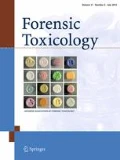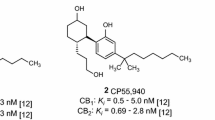Abstract
RCS-4 [(4-methoxyphenyl)-1-yl-(1-pentyl-1H-indol-3-yl)methanone] represents the first of several N-alkyl-3-(methoxybenzoyl)indoles identified by forensic scientists as synthetic cannabinoid (SC) designer drugs. Despite the detection of RCS-4 and several analogues (RCS-2, RCS-3, RCS-2-C4, RCS-3-C4, and RCS-4-C4) in products intended for human consumption, relatively little is known about this class of cannabinoids. The synthesis of all regioisomers of RCS-4 and their C4 homologues is described. This study also systematically explored the structure–activity relationships of this class of SCs at human CB1 and CB2 receptors using an in vitro fluorometric imaging plate reader membrane potential assay. All compounds demonstrated agonist activity at CB1 (EC50 = 54–574 nM) and CB2 (EC50 = 4.5–46 nM) receptors, with the C4 homologues showing a preference for CB2 receptors over CB1 receptors (31–42 times). Since most of the analogues (RCS-2, RCS-3, RCS-2-C4, RCS-3-C4 and RCS-4-C4) are not subject to regulation in much of the world, despite their activities towards CB1 and CB2 receptors, there is a possibility that these analogues will emerge on the black market.






Similar content being viewed by others
References
Dresen S, Ferreiros N, Putz M, Westphal F, Zimmermann R, Auwärter V (2010) Monitoring of herbal mixtures potentially containing synthetic cannabinoids as psychoactive compounds. J Mass Spectrom 45:1186–1194
Auwärter V, Dresen S, Weinmann W, Muller M, Putz M, Ferreiros N (2009) ‘Spice’ and other herbal blends: harmless incense or cannabinoid designer drugs? J Mass Spectrom 44:832–837
Pertwee RG, Howlett AC, Abood ME, Alexander SPH, Di Marzo V, Elphick MR, Greasley PJ, Hansen HS, Kunos G, Mackie K, Mechoulam R, Ross RA (2010) International Union of Basic and Clinical Pharmacology. LXXIX. Cannabinoid receptors and their ligands: beyond CB1 and CB2. Pharmacol Rev 62:588–631
Seely KA, Lapoint J, Moran JH, Fattore L (2012) Spice drugs are more than harmless herbal blends: a review of the pharmacology and toxicology of synthetic cannabinoids. Prog Neuropsychopharmacol Biol Psychiatry 39:234–243
Mir A, Obafemi A, Young A, Kane C (2011) Myocardial infarction associated with use of the synthetic cannabinoid K2. Pediatrics 128:e1622–e1627
Lapoint J, James LP, Moran CL, Nelson LS, Hoffman RS, Moran JH (2011) Severe toxicity following synthetic cannabinoid ingestion. Clin Toxicol 49:760–764
Simmons J, Cookman L, Kang C, Skinner C (2011) Three cases of “spice” exposure. Clin Toxicol 49:431–433
Schneir AB, Cullen J, Ly BT (2011) “Spice” girls: synthetic cannabinoid intoxication. J Emerg Med 40:296–299
Schneir A, Baumbacher T (2012) Convulsions associated with the use of a synthetic cannabinoid product. J Med Toxicol 8:62–64
Harris CR, Brown A (2013) Synthetic cannabinoid intoxication: a case series and review. J Emerg Med 44:360–366
Uchiyama N, Shimokawa Y, Kawamura M, Kikura-Hanajiri R, Hakamatsuka T (2014) Chemical analysis of a benzofuran derivative, 2-(2-ethylaminopropyl)benzofuran (2-EAPB), eight synthetic cannabinoids, five cathinone derivatives, and five other designer drugs newly detected in illegal products. Forensic Toxicol 32:266–281
European Monitoring Centre for Drugs and Drug Addictions (2014) European Drug Report 2014: trends and developments. Euro Surveill. doi:10.2810/32306
Wilkinson SM, Banister SD, Kassiou M (2015) Bioisosteric fluorine in the clandestine design of synthetic cannabinoids. Aust J Chem 68:4–8
Nakajima J, Takahashi M, Seto T, Kanai C, Suzuki J, Yoshida M, Hamano T (2011) Identification and quantitation of two benzoylindoles AM-694 and (4-methoxyphenyl)(1-pentyl-1H-indol-3-yl)methanone, and three cannabimimetic naphthoylindoles JWH-210, JWH-122, and JWH-019 as adulterants in illegal products obtained via the Internet. Forensic Toxicol 29:95–110
Nakajima J, Takahashi M, Nonaka R, Seto T, Suzuki J, Yoshida M, Kanai C, Hamano T (2011) Identification and quantitation of a benzoylindole (2-methoxyphenyl)(1-pentyl-1H-indol-3-yl)methanone and a naphthoylindole 1-(5-fluoropentyl-1H-indol-3-yl)-(naphthalene-1-yl)methanone (AM-2201) found in illegal products obtained via the Internet and their cannabimimetic effects evaluated by in vitro [35S]GTPγS binding assays. Forensic Toxicol 29:132–141
Logan BK, Reinhold LE, Xu A, Diamond FX (2012) Identification of synthetic cannabinoids in herbal incense blends in the United States. J Forensic Sci 57:1168–1180
Denooz R, Vanheugen JC, Frederich M, de Tullio P, Charlier C (2013) Identification and structural elucidation of four cannabimimetic compounds (RCS-4, AM-2201, JWH-203 and JWH-210) in seized products. J Anal Toxicol 37:56–63
Choi H, Heo S, Choe S, Yang W, Park Y, Kim E, Chung H, Lee J (2013) Simultaneous analysis of synthetic cannabinoids in the materials seized during drug trafficking using GC–MS. Anal Bioanal Chem 405:3937–3944
Couch RAF, Madhavaram H (2012) Phenazepam and cannabinomimetics sold as herbal highs in New Zealand. Drug Test Anal 4:409–414
Zuba D, Byrska B (2013) Analysis of the prevalence and coexistence of synthetic cannabinoids in “herbal high” products in Poland. Forensic Toxicol 31:21–30
Simolka K, Lindigkeit R, Schiebel H-M, Papke U, Ernst L, Beuerle T (2012) Analysis of synthetic cannabinoids in “spice-like” herbal highs: snapshot of the German market in summer 2011. Anal Bioanal Chem 404:157–171
Park Y, Lee C, Lee H, Pyo J, Jo J, Lee J, Choi H, Kim S, Hong RS, Park Y, Hwang BY, Choe S, Jung JH (2013) Identification of a new synthetic cannabinoid in a herbal mixture: 1-butyl-3-(2-methoxybenzoyl)indole. Forensic Toxicol 31:187–196
Chung H, Choi H, Heo S, Kim E, Lee J (2014) Synthetic cannabinoids abused in South Korea: drug identifications by the National Forensic Service from 2009 to June 2013. Forensic Toxicol 32:82–88
Hutter M, Broecker S, Kneisel S, Auwärter V (2012) Identification of the major urinary metabolites in man of seven synthetic cannabinoids of the aminoalkylindole type present as adulterants in ‘herbal mixtures’ using LC–MS/MS techniques. J Mass Spectrom 47:54–65
Kavanagh P, Grigoryev A, Melnik A, Simonov A (2012) The identification of the urinary metabolites of 3-(4-methoxybenzoyl)-1-pentylindole (RCS-4), a novel cannabimimetic, by gas chromatography–mass spectrometry. J Anal Toxicol 36:303–311
Gandhi AS, Zhu M, Pang S, Wohlfarth A, Scheidweiler KB, Huestis MA (2014) Metabolite profiling of RCS-4, a novel synthetic cannabinoid designer drug, using human hepatocyte metabolism and TOF–MS. Bioanalysis 6:1471–1485
Scheidweiler KB, Huestis MA (2014) Simultaneous quantification of 20 synthetic cannabinoids and 21 metabolites, and semi-quantification of 12 alkyl hydroxy metabolites in human urine by liquid chromatography–tandem mass spectrometry. J Chromatogr A 1327:105–117
Hutter M, Kneisel S, Auwärter V, Neukamm MA (2012) Determination of 22 synthetic cannabinoids in human hair by liquid chromatography–tandem mass spectrometry. J Chromatogr B 903:95–101
Sundstroem M, Pelander A, Angerer V, Hutter M, Kneisel S, Ojanperae I (2013) A high-sensitivity ultra-high performance liquid chromatography/high-resolution time-of-flight mass spectrometry (UHPLC–HR-TOFMS) method for screening synthetic cannabinoids and other drugs of abuse in urine. Anal Bioanal Chem 405:8463–8474
Wohlfarth A, Scheidweiler KB, Chen X, H-f Liu, Huestis MA (2013) Qualitative confirmation of 9 synthetic cannabinoids and 20 metabolites in human urine using LC–MS/MS and library search. Anal Chem 85:3730–3738
Kronstrand R, Brinkhagen L, Birath-Karlsson C, Roman M, Josefsson M (2014) LC–QTOF–MS as a superior strategy to immunoassay for the comprehensive analysis of synthetic cannabinoids in urine. Anal Bioanal Chem 406:3599–3609
Kneisel S, Auwärter V (2012) Analysis of 30 synthetic cannabinoids in serum by liquid chromatography–electrospray ionization tandem mass spectrometry after liquid–liquid extraction. J Mass Spectrom 47:825–835
Kneisel S, Speck M, Moosmann B, Corneillie TM, Butlin NG, Auwärter V (2013) LC/ESI–MS/MS method for quantification of 28 synthetic cannabinoids in neat oral fluid and its application to preliminary studies on their detection windows. Anal Bioanal Chem 405:4691–4706
Kneisel S, Auwärter V, Kempf J (2013) Analysis of 30 synthetic cannabinoids in oral fluid using liquid chromatography–electrospray ionization tandem mass spectrometry. Drug Test Anal 5:657–669
Ammann J, McLaren JM, Gerostamoulos D, Beyer J (2012) Detection and quantification of new designer drugs in human blood: part 1—synthetic cannabinoids. J Anal Toxicol 36:372–380
Ito Y, Kobayashi K, Seko N, Saegusa T (1984) Indole syntheses utilizing o-methylphenyl isocyanides. Bull Chem Soc Jpn 57:73–84
Blaazer AR, Lange JHM, van der Neut MAW, Mulder A, den Boon FS, Werkman TR, Kruse CG, Wadman WJ (2011) Novel indole and azaindole (pyrrolopyridine) cannabinoid (CB) receptor agonists: design, synthesis, structure–activity relationships, physicochemical properties and biological activity. Eur J Med Chem 46:5086–5098
Bruker (2011) Apex2 suite of programs. Bruker AXS Inc., Madison
Sheldrick GM (2008) A short history of SHELX. Acta Crystallogr A 64:112–122
Banister SD, Wilkinson SM, Longworth M, Stuart J, Apetz N, English K, Brooker L, Goebel C, Hibbs DE, Glass M, Connor M, McGregor IS, Kassiou M (2013) The synthesis and pharmacological evaluation of adamantane-derived indoles: cannabimimetic drugs of abuse. ACS Chem Neurosci 4:1081–1092
Banister SD, Stuart J, Kevin RC, Edington A, Longworth M, Wilkinson SM, Beinat C, Buchanan AS, Hibbs DE, Glass M, Connor M, McGregor IS, Kassiou M (2015) The effects of bioisosteric fluorine in synthetic cannabinoid designer drugs JWH-018, AM-2201, UR-144, XLR-11, PB-22, 5F-PB-22, APICA, and STS-135. ACS Chem Neurosci. doi:10.1021/acschemneuro.5b00107
Knapman A, Santiago M, Du YP, Bennallack PR, Christie MJ, Connor M (2013) A continuous, fluorescence-based assay of µ-opioid receptor activation in AtT-20 cells. J Biomol Screen 18:269–276
Okauchi T, Itonaga M, Minami T, Owa T, Kitoh K, Yoshino H (2000) A general method for acylation of indoles at the 3-position with acyl chlorides in the presence of dialkylaluminum chloride. Org Lett 2:1485–1487
Grimsey NL, Graham ES, Dragunow M, Glass M (2010) Cannabinoid receptor 1 trafficking and the role of the intracellular pool: implications for therapeutics. Biochem Pharmacol 80:1050–1062
Frost JM, Dart MJ, Tietje KR, Garrison TR, Grayson GK, Daza AV, El-Kouhen OF, Miller LN, Li L, Yao BB, Hsieh GC, Pai M, Zhu CZ, Chandran P, Meyer MD (2008) Indol-3-yl-tetramethylcyclopropyl ketones: effects of indole ring substitution on CB2 cannabinoid receptor activity. J Med Chem 51:1904–1912
Frost JM, Dart MJ, Tietje KR, Garrison TR, Grayson GK, Daza AV, El-Kouhen OF, Yao BB, Hsieh GC, Pai M, Zhu CZ, Chandran P, Meyer MD (2010) Indol-3-ylcycloalkyl ketones: effects of N1 substituted indole side chain variations on CB2 cannabinoid receptor activity. J Med Chem 53:295–315
Acknowledgments
Work was supported in part by the European Union’s Seventh Framework Programme [FP7/2007–2013] INMiND (Grant agreement No. HEALTH-F2-2011-278850). MC was supported by NHMRC Project Grant 1002680, and JS by an iMQRES Postgraduate Scholarship from Macquarie University.
Conflict of interest
There are no financial or other relations that could lead to a conflict of interest.
Ethical approval
This article does not contain any studies with human participants or animals performed by any of the authors.
Author information
Authors and Affiliations
Corresponding author
Electronic supplementary material
Below is the link to the electronic supplementary material.
Rights and permissions
About this article
Cite this article
Banister, S.D., Stuart, J., Conroy, T. et al. Structure–activity relationships of synthetic cannabinoid designer drug RCS-4 and its regioisomers and C4 homologues. Forensic Toxicol 33, 355–366 (2015). https://doi.org/10.1007/s11419-015-0282-9
Received:
Accepted:
Published:
Issue Date:
DOI: https://doi.org/10.1007/s11419-015-0282-9




